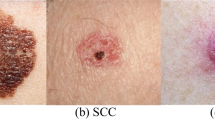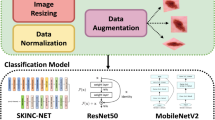Abstract
Skin cancer diagnosis relies on assessing the histopathological appearance of skin cells and the patterns of epithelial skin tissue architecture. Despite recent advancements in deep learning for automating skin cancer detection, two main challenges persist for their clinical deployment. (1) Deep learning models only recognize the classes trained on, giving arbitrary predictions for rare or unknown diseases. (2) The generalization across healthcare institutions, as variations arising from diverse scanners and staining procedures, increase the task complexity. We propose a novel Domain Adaptation method for Unsupervised cancer Detection (DAUD) using whole slide images to address these concerns. Our method consists of an autoencoder-based model with stochastic latent variables that reflect each institution’s features. We have validated DAUD in a real-world dataset from two different hospitals. In addition, we utilized an external dataset to evaluate the capability for out-of-distribution detection. DAUD demonstrates comparable or superior performance to the state-of-the-art methods for anomaly detection https://github.com/cvblab/DAUD-MICCAI2024.
The first two authors contributed equally.
Access this chapter
Tax calculation will be finalised at checkout
Purchases are for personal use only
Similar content being viewed by others
References
Abels, E., Pantanowitz, L., Aeffner, F., Zarella, M.D., van der Laak, J., Bui, M.M., Vemuri, V.N., Parwani, A.V., Gibbs, J., Agosto-Arroyo, E., et al.: Computational pathology definitions, best practices, and recommendations for regulatory guidance: a white paper from the digital pathology association. The Journal of pathology 249(3), 286–294 (2019)
Ahmad, S., Lavin, A., Purdy, S., Agha, Z.: Unsupervised real-time anomaly detection for streaming data. Neurocomputing 262, 134–147 (2017)
del Amor, R., Colomer, A., Morales, S., Pulgarín-Ospina, C., Terradez, L., Aneiros-Fernandez, J., Naranjo, V.: A self-contrastive learning framework for skin cancer detection using histological images. In: 2022 IEEE International Conference on Image Processing (ICIP). pp. 2291–2295 (2022)
Apalla, Z., Lallas, A., Sotiriou, E., Lazaridou, E., Ioannides, D.: Epidemiological trends in skin cancer. Dermatology practical & conceptual 7(2), 1–6 (2017)
Del Amor, R., Launet, L., Colomer, A., Moscardó, A., Mosquera-Zamudio, A., Monteagudo, C., Naranjo, V.: An attention-based weakly supervised framework for spitzoid melanocytic lesion diagnosis in whole slide images. Artificial Intelligence in Medicine 121, 102197 (2021)
Del Amor, R., Pérez-Cano, J., López-Pérez, M., Terradez, L., Aneiros-Fernandez, J., Morales, S., Mateos, J., Molina, R., Naranjo, V.: Annotation protocol and crowdsourcing multiple instance learning classification of skin histological images: The CR-AI4SkIN dataset. Artificial Intelligence in Medicine 145, 102686 (2023)
Han, D., Wang, Z., Chen, W., Wang, K., Yu, R., Wang, S., Zhang, H., Wang, Z., Jin, M., Yang, J., et al.: Anomaly detection in the open world: Normality shift detection, explanation, and adaptation. In: 30th Annual Network and Distributed System Security Symposium (NDSS) (2023)
Higgins, I., Matthey, L., Pal, A., Burgess, C., Glorot, X., Botvinick, M., Mohamed, S., Lerchner, A.: beta-vae: Learning basic visual concepts with a constrained variational framework. In: International Conference on Learning Representations (ICLR) (2016)
Huang, Z., Bianchi, F., Yuksekgonul, M., Montine, T.J., Zou, J.: A visual–language foundation model for pathology image analysis using medical twitter. Nature Medicine pp. 1–10 (2023)
Jaber, M.I., Song, B., Taylor, C., Vaske, C.J., Benz, S.C., Rabizadeh, S., Soon-Shiong, P., Szeto, C.W.: A deep learning image-based intrinsic molecular subtype classifier of breast tumors reveals tumor heterogeneity that may affect survival. Breast Cancer Research 22, 1–10 (2020)
Kanwal, N., Pérez-Bueno, F., Schmidt, A., Engan, K., Molina, R.: The devil is in the details: Whole slide image acquisition and processing for artifacts detection, color variation, and data augmentation: A review. IEEE Access 10, 58821–58844 (2022)
Kingma, D.P., Welling, M.: Auto-encoding variational bayes. In: International Conference on Learning Representations (ICLR) (2014)
Van der Laak, J., Litjens, G., Ciompi, F.: Deep learning in histopathology: the path to the clinic. Nature medicine 27(5), 775–784 (2021)
Li, M., Abe, M., Nakano, S., Tsuneki, M.: Deep learning approach to classify cutaneous melanoma in a whole slide image. Cancers 15(6), 1907 (2023)
Li, Z., Zhao, Y., Hu, X., Botta, N., Ionescu, C., Chen, G.: Ecod: Unsupervised outlier detection using empirical cumulative distribution functions. IEEE Transactions on Knowledge and Data Engineering (2022)
Linmans, J., Elfwing, S., van der Laak, J., Litjens, G.: Predictive uncertainty estimation for out-of-distribution detection in digital pathology. Medical Image Analysis 83, 102655 (2023)
Linmans, J., Raya, G., van der Laak, J., Litjens, G.: Diffusion models for out-of-distribution detection in digital pathology. Medical Image Analysis 93, 103088 (2024)
Lu, M.Y., Williamson, D.F., Chen, T.Y., Chen, R.J., Barbieri, M., Mahmood, F.: Data-efficient and weakly supervised computational pathology on whole-slide images. Nature biomedical engineering 5(6), 555–570 (2021)
Macenko, M., Niethammer, M., Borland, D., Woosley, J.T., Guan, X., Schmitt, C., Thomas, N.E.: A method for normalizing histology slides for quantitative analysis. In: 2009 IEEE international symposium on biomedical imaging: from nano to macro (ISBI). pp. 1107–1110 (2009)
Mosquera-Zamudio, A., Launet, L., Del Amor, R., Moscardó, A., Colomer, A., Naranjo, V., Monteagudo, C.: A spitzoid tumor dataset with clinical metadata and whole slide images for deep learning models. Scientific Data 10(1), 704 (2023)
Pérez-Bueno, F., Serra, J.G., Vega, M., Mateos, J., Molina, R., Katsaggelos, A.K.: Bayesian k-svd for h and e blind color deconvolution. applications to stain normalization, data augmentation and cancer classification. Computerized Medical Imaging and Graphics 97, 102048 (2022)
Redko, I., Morvant, E., Habrard, A., Sebban, M., Bennani, Y.: Advances in domain adaptation theory. Elsevier (2019)
Ruff, L., Vandermeulen, R., Goernitz, N., Deecke, L., Siddiqui, S.A., Binder, A., Müller, E., Kloft, M.: Deep one-class classification. In: International Conference on Machine Learning (ICML). pp. 4393–4402. PMLR (2018)
Schlegl, T., Seeböck, P., Waldstein, S.M., Schmidt-Erfurth, U., Langs, G.: Unsupervised anomaly detection with generative adversarial networks to guide marker discovery. In: International conference on information processing in medical imaging. pp. 146–157. Springer (2017)
Shah, M.: Lrnet: Skin cancer classification using low-resolution images. In: 2021 International Conference on Communication information and Computing Technology. pp. 1–5 (2021)
Tellez, D., Litjens, G., Bándi, P., Bulten, W., Bokhorst, J.M., Ciompi, F., Van Der Laak, J.: Quantifying the effects of data augmentation and stain color normalization in convolutional neural networks for computational pathology. Medical Image Analysis 58, 101544 (2019)
Xiang, T., Song, Y., Zhang, C., Liu, D., Chen, M., Zhang, F., Huang, H., O’Donnell, L., Cai, W.: Dsnet: A dual-stream framework for weakly-supervised gigapixel pathology image analysis. IEEE Transactions on Medical Imaging 41(8), 2180–2190 (2022)
Yang, Z., Soltani, I., Darve, E.: Anomaly detection with domain adaptation. In: Proceedings of the IEEE/CVF Conference on Computer Vision and Pattern Recognition (CVPR). pp. 2957–2966 (2023)
Zhao, Y., Nasrullah, Z., Li, Z.: Pyod: A python toolbox for scalable outlier detection. Journal of Machine Learning Research 20(96), 1–7 (2019)
Zingman, I., Stierstorfer, B., Lempp, C., Heinemann, F.: Learning image representations for anomaly detection: application to discovery of histological alterations in drug development. Medical Image Analysis 92, 103067 (2024)
Acknowledgments
The work of N. P. García de la Puente was supported by the grant PID2022-140189OB-C21 funded by MICIU/AEI/10.13039/ 501100011033 ERDF/UE and FSE+. The work of M. López-Pérez was supported by the grant JDC2022-048318-I funded by MICIU/AEI/10.13039/501100011033 and the “European Union NextGenerationEU/PRTR”. This work was also supported by the project PID2022-140189OB-C21 (ASSIST) funded by MICIU/AEI/10.13039/501100011033 and by “FEDER, EU”.
Author information
Authors and Affiliations
Corresponding author
Editor information
Editors and Affiliations
Ethics declarations
Disclosure of Interests
The authors have no competing interests to declare that are relevant to the content of this article.
Rights and permissions
Copyright information
© 2024 The Author(s), under exclusive license to Springer Nature Switzerland AG
About this paper
Cite this paper
P. García-de-la-Puente, N., López-Pérez, M., Launet, L., Naranjo, V. (2024). Domain Adaptation for Unsupervised Cancer Detection: An Application for Skin Whole Slides Images from an Interhospital Dataset. In: Linguraru, M.G., et al. Medical Image Computing and Computer Assisted Intervention – MICCAI 2024. MICCAI 2024. Lecture Notes in Computer Science, vol 15004. Springer, Cham. https://doi.org/10.1007/978-3-031-72083-3_6
Download citation
DOI: https://doi.org/10.1007/978-3-031-72083-3_6
Published:
Publisher Name: Springer, Cham
Print ISBN: 978-3-031-72082-6
Online ISBN: 978-3-031-72083-3
eBook Packages: Computer ScienceComputer Science (R0)





